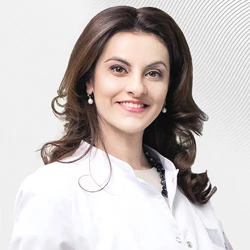Depression
There is such a thing in medicine – conditionally pathogenic flora – these are microorganisms that constantly live in various tissues of our body, perform a lot of useful work and normally do not cause us any harm. But under certain conditions (that's why they are called conditionally pathogenic), they become harmful and cause various diseases. Demodex folliculorum belongs to such microorganisms.
Many years of scientific research by domestic and foreign scientists have convincingly proved that every person has this microblast. It lives in the surface layers of the skin, mainly on the face, more in the nasolabial folds and root follicles of the eyelashes and participates in the processing and exfoliation of dead skin scales. However, in predisposing circumstances, the number of ticks increases many times - then the symptoms of the disease appear: inflammatory red "pimples", itchy eyelids.
The first thing that attracts attention when the Demodex folliculorum mite is activated is the appearance of small pink-red rashes on the skin of the face, very similar to "pimples". These rashes may be accompanied by mild itching. The largest number of them, as a rule, is located around the eyes, on the cheeks, chin, and nasolabial folds. Also, sometimes there may be an inflammatory reaction on the eyelids – redness, fine peeling, itching. Sometimes the eyebrow area is involved in this process, while in men the area of beard and mustache growth is involved.
Most modern dermatologists pay the main attention in the treatment of demodicosis not to the destruction of the tick, but to the elimination or correction of predisposing factors. These include, first of all, the structural features of the vascular bed of the skin, that is, a predisposition to the appearance of the "fashionable" rosacea or rosacea in our time.
The most important skin condition that can lead to demodicosis is chronic dermatosis, which has two names: rosacea or rosacea (acne). It is believed that for the first time this fairly common disease was described by the 14th century French surgeon Guy de Chauliac in a work called "Goutta rose de vin" - "Pink drops from wine" - as it is visually characterized by the appearance of pink-red acne-like (pimple-like) spots on the face, resembling droplets of red wine. Later, in the 19th century, the English dermatologist R.Willan described in detail the symptoms of the disease and suggested that its occurrence is associated with the improper functioning of the sebaceous glands. Today it is known that rosacea or pink acne are extremely common diseases, ranking 7th in the world in terms of frequency. Women suffer from rosacea 4 times more often than men, and people with light, sensitive skin prone to vascular reactions such as "skin inflammation" are particularly susceptible to this dermatosis.
Other causes include hormonal imbalance, psychovegetative disorders, seborrhea and other changes in the functioning of the sebaceous and hair apparatus, immune disorders, oxidative stress, digestive tract dysfunctions, and menopausal disorders.
Given these circumstances, it is better to entrust the treatment of demodicosis to specialists. In my practice, I often encounter neglected cases of the disease that are difficult to treat, due to attempts by patients or incompetent specialists to "cover up" the manifestations of the disease with various external preparations. This leads to a gradual transition of demodicosis into more severe forms. The main thing is to understand that demodicosis does not refer to a skin infection, but to skin manifestations of common metabolic disorders of the entire body.
Treatment of demodicosis
Fortunately, in recent years, scientific and technological progress in medicine has made it possible to quickly conduct research on the digestive and nervous systems, hormonal and immune status, and vascular bed. In recent years, a new method of treating rosacea or rosacea and demodicosis, which complicates their course, has proved to be the most successful – SIFT (selective pulsed phototherapy). Its essence is that infrared light enters the middle layers of the skin in short pulsed waves, without violating its integrity, precisely in the area where vascular disorders develop, and eliminates them. A properly conducted course of this type of physiotherapy allows you to permanently get rid of the increased activity of demodex.
Do not forget that the course of demodicosis, like any disease associated with a violation of the general metabolism in the body, is greatly influenced by the peculiarities of the patient's eating habits, harmful working conditions and much more.
Today, dermatologists are well aware of many factors that contribute to the onset and intensification of symptoms of rosacea and demodicosis.:
-
Food and alcoholic beverages: hot food, spicy and spicy foods, coffee and caffeinated beverages, alcohol (especially red wine), chocolate, some types of cheeses (parmesan, roquefort, blue cheeses), some vegetables (spinach, tomatoes, eggplant);
-
Medications: nicotinic acid, morphine and other opiates, some blood pressure medications, hormonal drugs from the group of glucocorticosteroids. Provoking factors are also the effect of high (sauna, steam room) and low (cryotherapy) temperatures and active ultraviolet radiation on the skin.
For proper treatment of demodicosis, it is necessary first of all to identify and eliminate all of the above factors that lead to rosacea.
-
Various dosage forms are used for external therapy: agitated suspensions, lotions, creams and ointments with anti-inflammatory and antiparasitic properties. Special attention is paid to basic facial skin care, which should include three main positions:
-
Gentle "gentle" cleansing;
-
Active humidification;
-
Reliable phototrotection (protection from solar radiation).
Further treatment tactics should be determined by a dermatologist.
In conclusion, I would like to note that the treatment of demodicosis requires patient and doctor to work together painstakingly, mutual trust and consistency.
Why the EMC
The first and only clinic in Russia, created in the image of the world's leading clinics
EMC is a multidisciplinary center offering patients a high level of medical services and a personalized approach
Worldwide recognition and awards
 Learn more
Learn more
Worldwide recognition and awards
 Certificates and licenses
Certificates and licenses
Make an appointment for a consultation
Specify your contacts and we will contact you to clarify the details
Reviews
and new products of the EMC


.webp)
.webp)
.webp)







